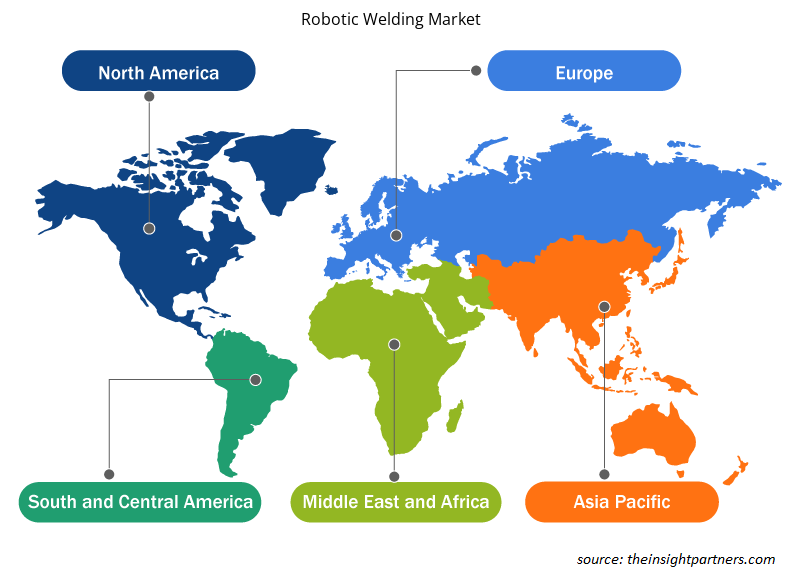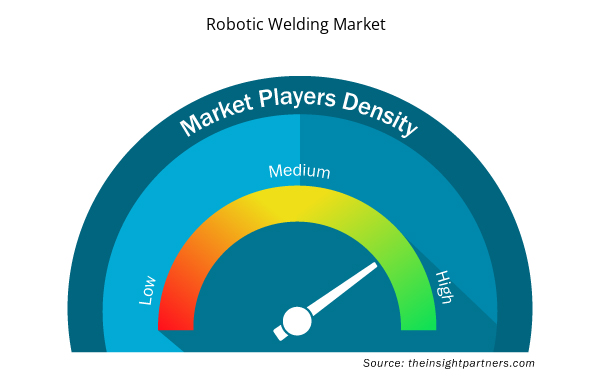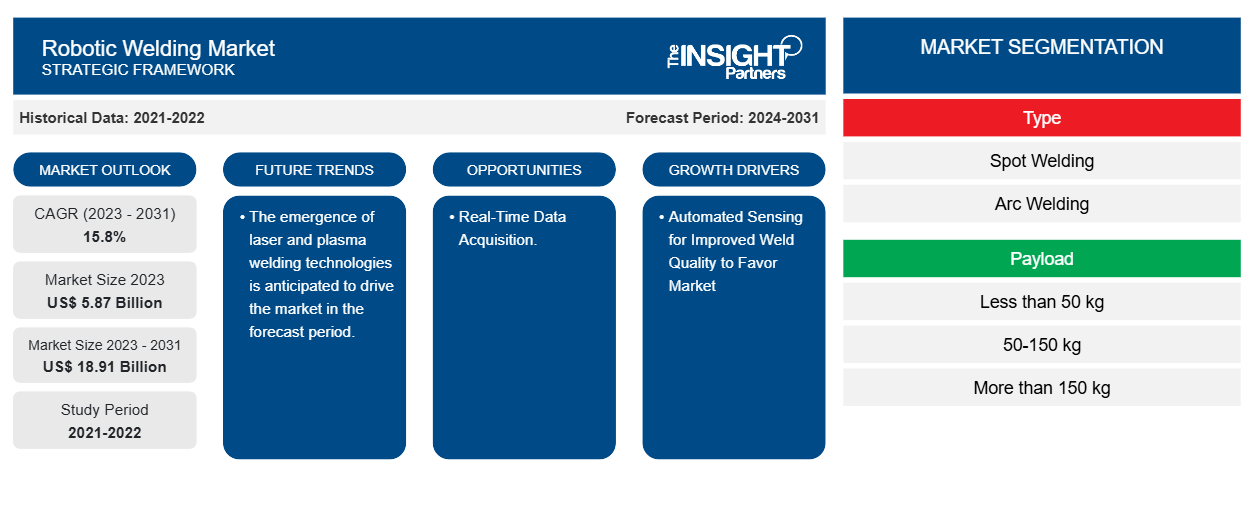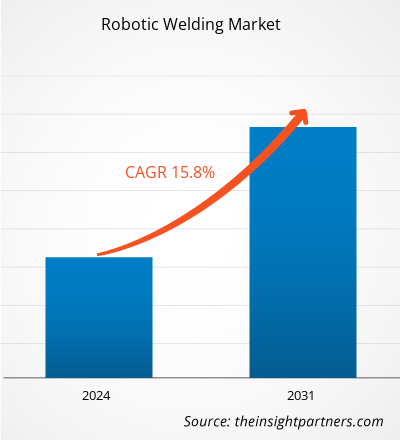ロボット溶接市場規模は、2023年の58億7,000万米ドルから2031年には189億1,000万米ドルに達すると予測されています。市場は2023年から2031年の間に15.8%のCAGRを記録すると予想されています。産業用ロボットの需要を促進するインダストリアル4.0と自動車産業における溶接ロボットの採用増加が、市場の主要な推進力とトレンドとなる可能性があります。
ロボット溶接市場分析
ロボット溶接市場は世界的に著しい成長を遂げています。この成長は、産業用ロボットの需要を牽引するインダストリアル4.0と、自動車産業における溶接ロボットの導入増加によるものです。さらに、 アジア太平洋地域におけるデジタル変革を支援する政府の取り組みや、レーザーおよびプラズマ溶接技術の出現も、ロボット溶接市場の成長を後押しする要因の1つです。
ロボット溶接市場の概要
ロボット溶接は、産業部門のプロセスの自動化、精度の向上、リードタイムの短縮、安全性の強化に役立つ方法です。ロボット溶接プロセスは、大量かつ反復的なタスクに実装された場合に最も生産性が高くなると考えられています。ロボット溶接プロセスには複数の種類があります。
要件に合わせてレポートをカスタマイズする
このレポートの一部、国レベルの分析、Excelデータパックなど、あらゆるレポートを無料でカスタマイズできます。また、スタートアップや大学向けのお得なオファーや割引もご利用いただけます。
- このレポートの主要な市場動向を入手してください。この無料サンプルには、市場動向から見積もりや予測に至るまでのデータ分析が含まれます。
ロボット溶接市場の推進要因と機会
自動センシングによる溶接品質の向上で市場を有利に
自動センシング技術により、ロボット溶接機は個々のワークピースの寸法に応じて操作を行うことができます。これにより、各溶接の品質が向上し、操作速度が上がり、結果としてスループットが向上します。これらの技術を各溶接セルに組み込むと、溶接操作を監視して詳細を記録し、継続的なプロセス最適化を行ったり、ワークピースに応じて溶接ロボットのパラメータを自動的に調整したり、溶接操作を監視して詳細を記録し、継続的なプロセス最適化を行ったりするのに役立ちます。
リアルタイムデータ取得
自動センシングとともに、ロボット溶接システムの運用データの取得と分析は急速に進歩しています。品質管理プロセスに適合するには各溶接に特定の検査が必要であるため、これらのツールを使用すると、溶接操作中に接合部の強度、各継ぎ目の密閉性、溶接の溶け込みを証明することができます。
アーク トラッキング制御システムは、欠陥を自動的に識別して溶接操作を修正し、通常は二次検査でのみ表面化する手直しを最小限に抑えることができます。さらに、これらのシステムは、溶接操作中のジョイント幅とプロファイルの測定、ジョイント エッジの検出、溶接中のシームの溶け込みの追跡を提供し、仕様に従って溶接の溶け込みを制御します。
ロボット溶接市場レポートのセグメンテーション分析
ロボット溶接市場分析の導出に貢献した主要なセグメントは、タイプ、ペイロード、およびエンドユーザーです。
- ロボット溶接市場は、種類別にスポット溶接、アーク溶接、その他に分類されます。電力管理コンポーネント部門は、予測期間中に大きな市場シェアを占めると予想されます。
- ロボット溶接市場は、積載量に基づいて、50 kg未満、50~150 kg、150 kg超に分けられます。50 kg未満のセグメントは、予測期間中に大きな市場シェアを占めると予想されます。
- エンドユーザー別に見ると、市場は自動車・輸送、電気・電子、金属・機械、建設に分類されます。予測期間中、自動車・輸送が大きな市場シェアを占めると予想されます。
ロボット溶接市場シェアの地域別分析
ロボット溶接市場レポートの地理的範囲は、主に北米、アジア太平洋、ヨーロッパ、中東およびアフリカ、南米および中米の 5 つの地域に分かれています。
北米はロボット溶接市場を支配してきました。北米地域のさまざまな業界でのハイテク採用の傾向が、ロボット溶接市場の成長を後押ししています。デジタルツールの採用の増加や政府機関による多額の技術支出などの要因が、北米のロボット溶接市場の成長を牽引すると予想されています。さらに、米国とカナダの先進国では研究開発に重点が置かれているため、北米のプレーヤーは技術的に高度なソリューションを市場に投入せざるを得ません。さらに、米国にはロボット溶接市場のプレーヤーが多数存在し、革新的なソリューションの開発にますます重点を置いています。これらすべての要因が、この地域のロボット溶接市場の成長に貢献しています。
ロボット溶接市場の地域別分析
予測期間を通じてロボット溶接市場に影響を与える地域的な傾向と要因は、Insight Partners のアナリストによって徹底的に説明されています。このセクションでは、北米、ヨーロッパ、アジア太平洋、中東、アフリカ、南米、中米にわたるロボット溶接市場のセグメントと地理についても説明します。

- ロボット溶接市場の地域別データを入手
ロボット溶接市場レポートの範囲
| レポート属性 | 詳細 |
|---|---|
| 2023年の市場規模 | 58億7千万米ドル |
| 2031年までの市場規模 | 189.1億米ドル |
| 世界のCAGR(2023年~2031年) | 15.8% |
| 履歴データ | 2021-2022 |
| 予測期間 | 2024-2031 |
| 対象セグメント | タイプ別
|
| 対象地域と国 | 北米
|
| 市場リーダーと主要企業プロフィール |
|
ロボット溶接市場のプレーヤー密度:ビジネスダイナミクスへの影響を理解する
ロボット溶接市場は、消費者の嗜好の変化、技術の進歩、製品の利点に対する認識の高まりなどの要因により、エンドユーザーの需要が高まり、急速に成長しています。需要が高まるにつれて、企業は提供を拡大し、消費者のニーズを満たすために革新し、新たなトレンドを活用し、市場の成長をさらに促進しています。
市場プレーヤー密度とは、特定の市場または業界内で活動している企業または会社の分布を指します。これは、特定の市場スペースに、その市場規模または総市場価値に対してどれだけの競合相手 (市場プレーヤー) が存在するかを示します。
ロボット溶接市場で事業を展開している主要企業は次のとおりです。
- パナソニック株式会社
- 安川電機株式会社
- ABB社
- ファナック株式会社
- IGM ロボットシステム
- 川崎重工業株式会社
免責事項:上記の企業は、特定の順序でランク付けされていません。

- ロボット溶接市場のトップキープレーヤーの概要を入手
ロボット溶接市場のニュースと最近の動向
ロボット溶接市場は、主要な企業出版物、協会データ、データベースなどの一次調査と二次調査後の定性的および定量的データを収集することによって評価されます。ロボット溶接市場の動向のいくつかを以下に示します。
- Kemppi は、新しいロボット溶接機 AX MIG 溶接機を発売しました。Kemppi AX MIG 溶接機のご紹介 – シームレスな統合、使いやすいインターフェース、最新の溶接技術を備えた強力なロボット溶接機です。AX MIG 溶接機は、高強度の 24 時間 365 日自動溶接環境向けに特別に設計されました。400 A または 500 A の電力とロボットワイヤフィーダーを備え、困難なタスクを実行し、厳しい生産目標を達成できるように設計されています。(出典: Kemppi 社の Web サイト、2023 年 4 月)
- 米国最大の女性所有の溶接ワイヤ専門ブランドである NS ARC と、業界で 100 年以上の経験を持つロボット溶接技術のパイオニアである CLOOS North America は、戦略的提携を誇りを持って発表します。(出典: NS ARC 企業 Web サイト、2024 年 7 月)
ロボット溶接市場レポートの対象範囲と成果物
「ロボット溶接市場の規模と予測(2021〜2031年)」レポートでは、以下の分野をカバーする市場の詳細な分析を提供しています。
- ロボット溶接市場の規模と予測は、対象範囲に含まれるすべての主要な市場セグメントについて、世界、地域、国レベルで示されます。
- ロボット溶接市場の動向、および推進要因、制約、主要な機会などの市場動向。
- 詳細な PEST/ポーターの 5 つの力と SWOT 分析。
- 主要な市場動向、世界および地域の枠組み、主要プレーヤー、規制、最近の市場動向を網羅したロボット溶接市場分析。
- 市場集中、ヒートマップ分析、主要プレーヤー、ロボット溶接市場の最近の動向を網羅した業界の状況と競争分析。
- 詳細な企業プロフィール。
- 過去2年間の分析、基準年、CAGRによる予測(7年間)
- PEST分析とSWOT分析
- 市場規模価値/数量 - 世界、地域、国
- 業界と競争環境
- Excel データセット



Report Coverage
Revenue forecast, Company Analysis, Industry landscape, Growth factors, and Trends

Segment Covered
This text is related
to segments covered.

Regional Scope
North America, Europe, Asia Pacific, Middle East & Africa, South & Central America

Country Scope
This text is related
to country scope.
よくある質問
The expected CAGR of the robotic welding market is 15.8%.
The global robotic welding market is expected to reach US$ 18.91 billion by 2031.
The key players holding majority shares in the global robotic welding market are Panasonic Corporation, Yaskawa Electric Corporation, ABB, Fanuc Corporation, IGM Robotersysteme, Kawasaki Heavy Industries, Ltd, Kuka Ag, Nachi Fujikoshi Corp, Novarc Technology, OTC Daihen.
The emergence of laser and plasma welding technologies is anticipated to drive the market in the forecast period.
Industrial 4.0 to drive demand for industrial robots and increasing adoption of welding robots in automotive industries are some of the factors driving the robotic welding market.
North America is anticipated to dominate the robotic welding market in 2023.
Trends and growth analysis reports related to Electronics and Semiconductor : READ MORE..
The Insight Partners performs research in 4 major stages: Data Collection & Secondary Research, Primary Research, Data Analysis and Data Triangulation & Final Review.
- Data Collection and Secondary Research:
As a market research and consulting firm operating from a decade, we have published and advised several client across the globe. First step for any study will start with an assessment of currently available data and insights from existing reports. Further, historical and current market information is collected from Investor Presentations, Annual Reports, SEC Filings, etc., and other information related to company’s performance and market positioning are gathered from Paid Databases (Factiva, Hoovers, and Reuters) and various other publications available in public domain.
Several associations trade associates, technical forums, institutes, societies and organization are accessed to gain technical as well as market related insights through their publications such as research papers, blogs and press releases related to the studies are referred to get cues about the market. Further, white papers, journals, magazines, and other news articles published in last 3 years are scrutinized and analyzed to understand the current market trends.
- Primary Research:
The primarily interview analysis comprise of data obtained from industry participants interview and answers to survey questions gathered by in-house primary team.
For primary research, interviews are conducted with industry experts/CEOs/Marketing Managers/VPs/Subject Matter Experts from both demand and supply side to get a 360-degree view of the market. The primary team conducts several interviews based on the complexity of the markets to understand the various market trends and dynamics which makes research more credible and precise.
A typical research interview fulfils the following functions:
- Provides first-hand information on the market size, market trends, growth trends, competitive landscape, and outlook
- Validates and strengthens in-house secondary research findings
- Develops the analysis team’s expertise and market understanding
Primary research involves email interactions and telephone interviews for each market, category, segment, and sub-segment across geographies. The participants who typically take part in such a process include, but are not limited to:
- Industry participants: VPs, business development managers, market intelligence managers and national sales managers
- Outside experts: Valuation experts, research analysts and key opinion leaders specializing in the electronics and semiconductor industry.
Below is the breakup of our primary respondents by company, designation, and region:

Once we receive the confirmation from primary research sources or primary respondents, we finalize the base year market estimation and forecast the data as per the macroeconomic and microeconomic factors assessed during data collection.
- Data Analysis:
Once data is validated through both secondary as well as primary respondents, we finalize the market estimations by hypothesis formulation and factor analysis at regional and country level.
- Macro-Economic Factor Analysis:
We analyse macroeconomic indicators such the gross domestic product (GDP), increase in the demand for goods and services across industries, technological advancement, regional economic growth, governmental policies, the influence of COVID-19, PEST analysis, and other aspects. This analysis aids in setting benchmarks for various nations/regions and approximating market splits. Additionally, the general trend of the aforementioned components aid in determining the market's development possibilities.
- Country Level Data:
Various factors that are especially aligned to the country are taken into account to determine the market size for a certain area and country, including the presence of vendors, such as headquarters and offices, the country's GDP, demand patterns, and industry growth. To comprehend the market dynamics for the nation, a number of growth variables, inhibitors, application areas, and current market trends are researched. The aforementioned elements aid in determining the country's overall market's growth potential.
- Company Profile:
The “Table of Contents” is formulated by listing and analyzing more than 25 - 30 companies operating in the market ecosystem across geographies. However, we profile only 10 companies as a standard practice in our syndicate reports. These 10 companies comprise leading, emerging, and regional players. Nonetheless, our analysis is not restricted to the 10 listed companies, we also analyze other companies present in the market to develop a holistic view and understand the prevailing trends. The “Company Profiles” section in the report covers key facts, business description, products & services, financial information, SWOT analysis, and key developments. The financial information presented is extracted from the annual reports and official documents of the publicly listed companies. Upon collecting the information for the sections of respective companies, we verify them via various primary sources and then compile the data in respective company profiles. The company level information helps us in deriving the base number as well as in forecasting the market size.
- Developing Base Number:
Aggregation of sales statistics (2020-2022) and macro-economic factor, and other secondary and primary research insights are utilized to arrive at base number and related market shares for 2022. The data gaps are identified in this step and relevant market data is analyzed, collected from paid primary interviews or databases. On finalizing the base year market size, forecasts are developed on the basis of macro-economic, industry and market growth factors and company level analysis.
- Data Triangulation and Final Review:
The market findings and base year market size calculations are validated from supply as well as demand side. Demand side validations are based on macro-economic factor analysis and benchmarks for respective regions and countries. In case of supply side validations, revenues of major companies are estimated (in case not available) based on industry benchmark, approximate number of employees, product portfolio, and primary interviews revenues are gathered. Further revenue from target product/service segment is assessed to avoid overshooting of market statistics. In case of heavy deviations between supply and demand side values, all thes steps are repeated to achieve synchronization.
We follow an iterative model, wherein we share our research findings with Subject Matter Experts (SME’s) and Key Opinion Leaders (KOLs) until consensus view of the market is not formulated – this model negates any drastic deviation in the opinions of experts. Only validated and universally acceptable research findings are quoted in our reports.
We have important check points that we use to validate our research findings – which we call – data triangulation, where we validate the information, we generate from secondary sources with primary interviews and then we re-validate with our internal data bases and Subject matter experts. This comprehensive model enables us to deliver high quality, reliable data in shortest possible time.


 このレポートの無料サンプルを入手する
このレポートの無料サンプルを入手する